- Survey on common knowledge (not all has been published)
- also: on open problems.
Definition: Canonical algebra.
|
|
Basic terms for canonical algebras:
- The tubes, their rank, left rank, right rank, the mouth, the
wings
- Separating property.
Separating substructures
Note: By definition, the piecewise hereditary algebras are those
finite dimensional algebras B
such that Db(mod B) is equivalent to Db(H) for some
hereditary category H, and then Db(mod B) is equivalent to
Db(mod A) for A a finite dimensional hereditary algebra or to
Db(mod C) for C a canonical algebra.
Thus, in order to understand mod B, one needs to look at the module categories
of finite dimensional hereditary algebras and of canonical algebras. These
are the algebras which have
- either a complete slice,
- or a separating tubular family.
The algebras tilted from a finite dimensional hereditary algebra or from a
canonical algebra are the quasi-tilted algebras.
Here one should mention the T

|
Why are the canonical algebras canonical?
Wiktionary (deutsch)
- Informatik: allgemeingültige und eindeutige Bezeichnung eines Datensatzes
- Mathematik: bezeichnet eine Darstellung in Normalform
Meyers Lexikon online:
- Physik: Bezeichnung für nach einer festen Regel gebildete Größen,
Operationen u. a., die für die Beschreibung eines
physikalischen Vorgangs am besten geeignet sind.
Wikipedia (english):
Religion24.net
- Kanonische Schriften gelten im kirchlichen Sinne als verbindlich.
Nach ihnen muss sich jeder Gläubige richten.
- Ein Kanon war ein Holzstab, der im antiken, athletischen Wettkampf
zur Messung der Sprungweite der Athleten diente.
(canon = a wooden stick for measuring the leap for jumping athlets)
|
Let me change the title:
In which way are the canonical algebras canonical?
We consider a special class: the tame concealed algebras.
The importance of this class of algebras is well-known
- see the Bongartz criterion.
- they can be classified: this was done by Happel and Vossieck.
Gabriel wrote in his Bourbaki lectures on rep-finite self-injective
algebras: The relevance of this class comes from the fact that they have been
classified by Riedtmann.
- The T

The domestic canonical algebras form just the crossing of the T:
Horizontally, the hereditary algebras are exhibited,
Vertically the canonical ones.

Aim: In any derived equivalence class, one wants a representative - just one.
Main observation.
Any derived equivalence class of domestic canonical algebras
contains usually many hereditary algebras, but just one canonical algebra.
First attempt: To choose one hereditary algebra
This means: to choose one orientation.
- Clear for type A: one sink, one source (but this is actually a canonical algebra)
- Clear for types E: take the subspace orientation
But why not the factor space orientation?
- Types D: For n=4 one would like to take the subspace orientation.
But there is nothing similar for n > 4.
For any n one could take: two sinks with distance 2, two sources with distance 2
(at least self-opposite).
Not really convincing.
Remark: Simson-Skowronski call these quivers the "canonically oriented Euclidean quivers".
They need these orientations for case-by-case proofs.
The HV-list
Reprinted in various publications, with different ordering.
- Happel-Vossieck. Manuscr. Math. 42 (1983), 221-243
also in SLNM 1099
- Bongartz. Math. Ann. 269 (1984), 1-12
- Von Hoehne. Commentarii Math. Helv. 63 (1988), 312-336.
- Bautista-Gabriel-Roiter-Salmeron. Inventiones Math. 81 (1985), 217-285.
Chaotic: Except for type A, the canonical algebras are missing.
- Simson-Skowronski. vol II.
References, in particular:
- Aslak Bakke Buan, Idun Reiten, and Ahmet I. Seven:
Tame concealed algebras and cluster quivers of minimal infinite type
Journal of Pure and Applied Algebra, 211 (2007) 71-82.
The tilting order of the tame concealed algebras:
We need a notion: down-tilting: the tilting pair
(X(T),Y(T)) splits.
- Definition of the poset ?? (Use of Gabrielov transformations?),
There are unpublished investigations of Vossieck. See also von Hoehne.
- An important invariant: the shortage =
the number of lost (= mixed) indecomposable modules
Domestic canonical algebras
General notation:
n = rank of the Grothendieck group K0(C)
d = (d1,...,d1) = positive radical generator of the quadratic
form on K0(C)
|d| = ∑ di.
Part I. Properties
1. The positive radical generator d
Formulation in terms of modules:
-
There exists an indecomposable module M of length n
with self-extensions.
|
- RED Up to shift and symmetry, there is only one tilting set in ZΔ
which contains only objects in the extension orbits.
|
(Here we use that di = dim HomA(Ti,H)
= -defect Ti)
2. Shortage
Let T be a preprojective A-tilting module, A hereditary.
The shortage of T or End(T) is the number s(T) of isoclasses of mixed modules.
Remark: The mixed modules have defect < -1.
Proof: They are extensions of two non.zero preprojective modules.
Note: The shortage is 0 iff End(T) is hereditary.
Here are the maximal values for the shortage :
| Tubular type | Apq | Dn | E6
| E7 | E8
|
|---|
| Maximal shortage | 0 | binom(n-2,2) | 13 | 43 | 164
|
|---|
The numbers s(Δ) are the following ("superfluity"):
s(Δ) = ∑x in Φ+ max xi - |Φ+|
Proof: There is a bijection between the pairs (x,t) with x a positive
root and 1 ≤ t < max xi and the mixed roots r for the canonical
algebra with r0 ≥1: attach to the pair (x,t) the difference
x - t(1,...,1).
Ordering of the Happel-Vossieck list according to shortage:
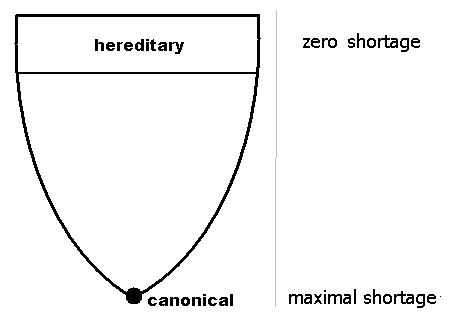
Mottation ordering using the Bongartz complement: Consider preprojective
tilting modules containing at least one projective summand, delete
a summand such that no propersuccessor is a summand, and add the
Bongartz complement.
- Sprungweite ist größt-möglich - greatest possible leap.
Also we see nicely the leaps.
The canonical configurations:
3. Sinks and sources
- There is only one sink and only one source.
|
- only one simple module is projective, only
one simple module is injective.
|
This means: we see the Kronecker.
Here, we should stress the importance of the exceptional pair
(t0,t∞) in ZΔ
with dim Hom(T0,T∞) = 2.
What means the 2?
- Increase of one component when reflecting.
- 2-Kronecker pair
Here, the tubular type E6. First, the calculation of the
hammock for an extension vertex:

Then the unique completion to a tilting set:

Next, the tubular type E7. First, the calculation of the
hammock for an extension vertex:

Then the unique completion to a tilting set:
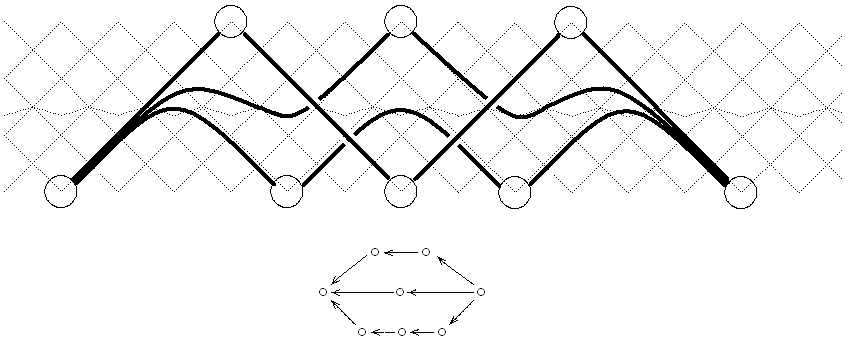
And the tubular type D8. First, the calculation of the
hammock for an extension vertex:
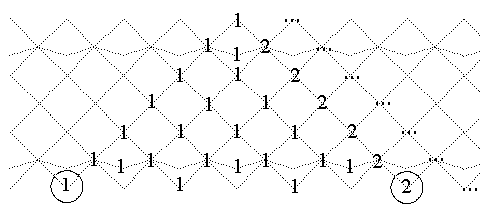
Then the unique completion to a tilting set:
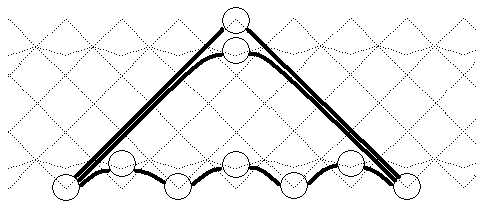
4. Simple regular modules
- Any tube of rank r contains r-1 simple modules.
|
Recall the formula for the ranks of the tubes: Σ (ri-1) = n-2.
Note: If all boundary modules of a tube are simple, then these simple
modules form a component of the Ext-quiver; in particular, the Ext-quiver is not
directed.
- All but 2 simple modules are regular.
|
This implies:
Simple modules are projective, regular, or injective
The converse is not true: Take D4\tilde,
with 2 sinks and 2 sources.
RED: The canonical algebra displays well in which way the extended Dynkin diagrams
are extended!
Experienced mathematicians know for each extended Dynkin diagram which of
the vertices can be considered as the extension vertex -
But looking at the quiver of the canonical algebra, no guessing is needed.
|
5. 2-Kronecker pairs
We call a pair of B-modules (X,Y) an n-Kronecker pair, provided
this is an orthogonal pair of bricks and dim Ext1(Y,X) = n
(thus, the category of B-modules M with an exact sequence
0 → Xa → M → Yb → 0 is equivalent to
the category of 2-Kronecker modules).
For a canonical algebra, the structure of all Kronecker pairs (X,Y) is obvious:
- the module X is preprojective and colocal,
- the module Y is preinjective and local,
- dim X + dim Y = d.
The number of such pairs is ∏ pi.
- There is a 2-Kronecker pair (X,Y) with X simple
|
- There is a 2-Kronecker pair (X,Y) with Y simple.
|
Actually: Characterizations
Theorem: For A tame concealed, any of these properties is
equivalent to being canonical.
These characterizations concern smallness or largeness of some invariants.
Small:
Large:
- shortage
- the length of the Scheuer hammock (later)
To repeat: Direct display of important properties and invariants
We can read off information:
- The positive generator of the radical of the quadratic form.
- The tubular type.
- The simple regular modules.
- Numerical criterion for preprojective - regular - preinjective:
x0-x∞ (just two non-zero coefficients).
- The 2-Kronecker exceptional pairs. For the canonical algebras, this number is
p = ∏pi.
- The lengths of preprojective serial modules which are maximal (i.e. not a proper
subfactor of a serial module) are p1, ..., pt,
The lengths of preinjective serial modules which are maximal
are p1, ..., pt,
The lengths of regular serial modules which are maximal
are p1-1, ..., pt-1,
Part II. The ideal lattice of a canonical algebra
Let us look at I = left-socle ∩ right-socle of C.
- There are q+1 one-dimensional ideals Iλ such that C/Iλ
has at least one sincere indecomposable module Mλ.
The module Mλ may not be faithful.
Actually: The number of sincere indecomposable C/Iλ-modules is
precisely p(λ).
Thus: we recover the canonical configuration
p:P(k2) → N1
looking at the set of ideals I in rad C such that C/I has a faithful module.
- Consequence:
- C has sincere indecomposable modules which are not faithful.
|
Recall Jans: On indecompsable representations of algebras. Annals Math. 66 (1957), 418-239.
- If the ideal lattice of an algebra C is not distributive, then C is of rep-infinite.
Thus, Jans asserts: canonical algebras are rep-infinite.
These are the only tame concealed algebras which were known quite
early to be of infinite representation type.
By the way: The first Jans condition + preprejective tilting yields all what one
needs for the Bongartz criterion.
Also note: If we deal with a minimal rep-infinite algebra with non-distributive
ideal lattice, then this concerns the socle...
Part III. Further Characterizations
6. Diamonds
- In case the base field has at least 3 elements:
There is sincere diamond.
|
7. Local modules
- There is a 1-parameter family of local modules
|
Brauer-Thrall 1+1/2 implies: strongly unbounded representation type.
- There are local modules with self-extensions.
|
We obtain indecomposable Prüfer modules with local factors.
7*. Colocal modules
- There is a 1-parameter family of colocal modules
|
- There are colocal modules with self-extensions.
|
8. Projective modules
- Every indecomposable projective module has defect -1.
|
This means: it can be embedded into the generic module such that the factor module
is a direct sum of Prüfer modules.
- There exists an indecomposable projective module which is not thin.
|
Note: from 7 to 8. If Ext1(P/U,P/U) ≠ 0, then
Hom(U,P/U) ≠ 0, thus P is not thin.
8*. Injective modules
- Every indecomposable injective module has defect 1.
|
- There exists an indecomposable omjective module which is not thin.
|
9. Generic module
- If M is the generic module, then Mα is bijective, for any
arrow α.
|
10. Indecomposable modules which are thin and sincere
- The number of such modules is
| 0 | if there exists a zero relation,
|
| 1 | if there are only commutativity relations and the algebra is not canonical,
|
| ≥ |k|+1 | if the algebra is canonical.
|
Part IV. Cluster-tilted algebras
Tilted algebras are no longer considered as basic objects,
they are just special factor algebras of cluster-tilted algebras.
Our characterizations dealt with tilted algebras.
Question: Are there similar characterizations of the corresponding cluster
tilted algebras?
The cluster-tilted algebras for the canonical algebras:
- One additional arrow ω → 0.
Important:
The shortage is the number of mixed modules for the corresponding cluster tilted
algebra.
The mixed modules for the cluster tilted algebra is a hammock,
namely the hammock of all indecomposable modules for the cluster tilted algebra which
are not annihilated by the additional arrow
(this is the Scheuer hammock
for the indecomposable length 2 module with composition factors 0 and ω)
As an example, the tubular type E6. First, the canonical
tilting set:

The transjective component of the cluster tilted algebra is obtained from
ZΔ by factoring out this tilting set.
This yields projective vertices (blue circles) and injective vertices
(red squares):

The Scheuer hammock for the mixed modules, it starts at P(ω)
and ends at Q(0):

The yellow spot marks
the indecomposable length 2 module with composition factors 0 and ω
Here is the Scheuer hammock for the algebra defined by the subquiver


Next, the tubular type E7. First, the canonical
tilting set:

Here is the Scheuer hammock for the mixed modules, it starts at P(ω)
and ends at Q(0):
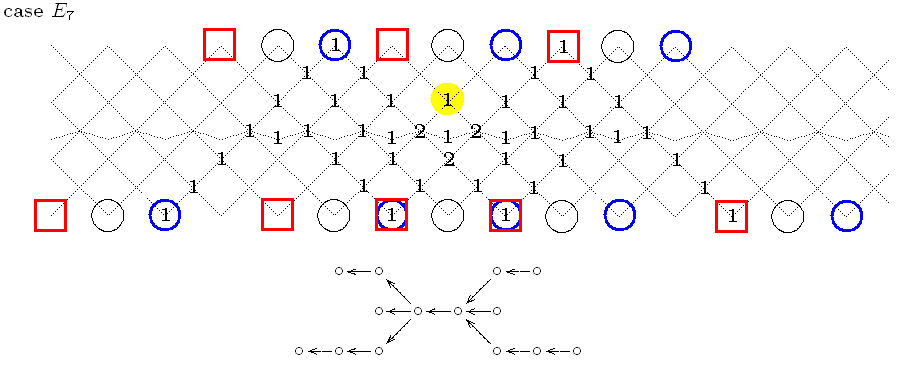
The yellow spot marks again
the indecomposable length 2 module with composition factors 0 and ω.
Note:
RED: We obtain the cluster-tilted algebras in the following way:
- Take a cluster category C
- take a cluster-tilted object T in C,
- and form End(T) in .
Here we are dealing with the case
- C is of Euclidean type
- all summands of T are transjective.
|
An obvious interesting invariant is the maximal length l of a
non-sectional path from some Ti to some Tj.
- For End(T) hereditary, this invariant is 0,
- For the canonical (cluster-)tilting objects, this invariant becomes
maximal.
Here is the list of the maximal values:
| Tubular type | Apq | Dn | E6
| E7 | E8
|
|---|
| Maximal length | 0 | 2(n-2) | 12 (=3×4) | 24 (= 4×6)
| 60 (= 5×12)
|
|---|
Here we see zhe number and the length of the leaps...
One further argument
Consider a canonical algebra C.
- The proof of the separation property is easy.
- The relationship with the Kronecker algebra is completely clear.
- Also: easy extension to non-algebraically closed fields.
Squids
- Brenner-Butler
- Crawley-Boevey
- Now: Henning
There is a left squid and a right squid, this yields non-regular tubes.
There is an obvious transition: left squid - canonical - right squid,
look at the repetitive algebra for
Note: generalizations of the squids (as well as of the canonical algebras)
are nice for dealing with repetitive algebras
Recall:
- RED: Essentially, there is only one tilting set in ZΔ
which contains only objects in the extension orbits.
Also, essentially, there is only one canonical pair in ZΔ,
and this pair
has a unique completion inside ZΔ to a tilting set.
|
Of course, the squids also use the canonical pair, but here the completion
is done outside of the component.
Tilted algebras
It seems: The only tilted algebras with q(1,...,1) = 0 are the canonical ones.
The canonical algebras should be considered as "canonical" for the appearance
of a rational 1-parameter family of bricks.













